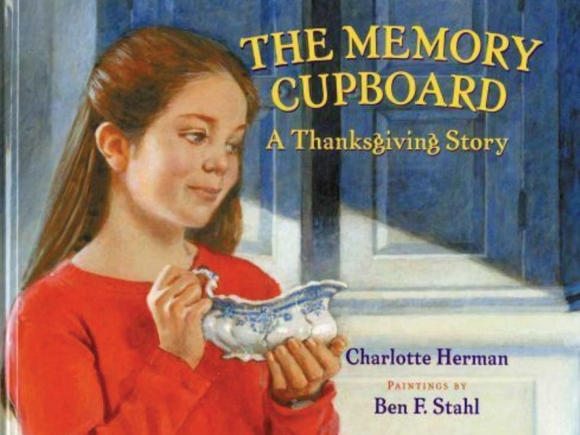Family, friends and gratitude: a great American holiday

With Thanksgiving just around the corner, I raided my public library, brought home an armload of books having to do with Turkey Day, and am delighted to share them with you here.
First up is “Fat Chance Thanksgiving” (Albert Whitman & Company, 2001, 32 pages). Written by Patricia Lakin and illustrated by Stacey Schuett, this children’s book tells the story of Carla and her inner-city family. When a fire destroys their apartment building, Carla’s only possession that survives the flames is her book, “A Pilgrim Thanksgiving.” The book becomes a sort of talisman, inspiring her to try and put together a Thanksgiving dinner in the lobby of their new apartment building. “Fat chance,” her mother tells her.
Carla goes door to door, explaining her plans to her neighbors for a shared feast, and by Thanksgiving Day the long table in the lobby is loaded with dishes like lasagna, black-eyed peas, Irish stew, fried okra, and of course, turkey and stuffing.
“Fat Chance Thanksgiving” can remind children — and the rest of us — that Thanksgiving is about friends, family, neighbors, and gratitude.
Enriched by the paintings of Ben F. Stahl, Charlotte Herman’s “The Memory Cupboard: A Thanksgiving Story” (Albert Whitman & Company, 2003, 32 pages) features a child, Katie, and a family get-together at her grandmother’s house for the holiday. During the meal Katie drops and breaks a white gravy boat treasured by Grandma. Katie bursts into tears, but then this wise grandmother takes her by the hand and leads her to her memory cupboard, which is filled with broken objects — toys, lamps, clocks, china — all of which mean much to her. “Every object here has a story to tell,” she says, and then shares some of those stories with her granddaughter.
Grandma ends by telling Katie, “Sometimes, no matter how careful we are, things we’re fond of get broken. But things are just things. People are more important, especially granddaughters.”
Related Items
There’s a great lesson for us all of us.
For those looking for a story about the Pilgrims, there is “The Thanksgiving Story” (Atheneum Books, 1954, 32 pages). Written by Alice Dalgliesh and illustrated by Helen Sewell, this Caldecott Honor Book follows the Hopkins family as they make their way from Southampton in England to what would become New England. Historically accurate and easy to understand, The Thanksgiving Story can be shared with K-3rd grade crew.
Of course, good books about Thanksgiving for older readers can also be found. Of the four I picked up at the library — I didn’t read these, but browsed through them — my favorite is Melanie Kirkpatrick’s “Thanksgiving: The Holiday at the Heart of the American Experience” (Encounter Books, 2016, 280 pages).
In this lively volume Kirkpatrick covers everything from the first Thanksgiving to “Turkey bowls,” football games played on Thanksgiving Day.
In her chapter on these sports contests, Kirkpatrick has collected many fascinating facts and anecdotes, just as she does throughout the rest of the book. Here, for example, we learn that “in 1893, one hundred twenty thousand athletes played in five thousand Thanksgiving games across the country ….” In 1900, in what later became known as the Thanksgiving Day Disaster, hundreds of fans in San Francisco climbed onto the roof of a factory near the field of a football game. The roof collapsed, with 23 people dying and many more injured. “The Thanksgiving Day Disaster was — and still is — the worst accident at a sporting event in the United States.”
A few days before this catastrophe, a Virginia newspaper published “Origin of Thanksgiving Day,” poking gentle fun at America’s obsession with football:
“We ought to do something to make ourselves solid with posterity,” remarked one of the Pilgrim Fathers.
“That’s so,” replied his companion. “How would it be to inaugurate a national holiday that will be a convenient time for football games?”
In a chapter titled “Thanksgiving’s Godmother,” Kirkpatrick provides an excellent mini-biography of Sarah Josepha Hale who, when widowed at age 34, leaving her to provide for four children and one on the way, eventually became editor of “Godey’s Lady’s Book,” which under her guiding hand “became the most widely read periodical in the United States on the eve of the Civil War.” Though she became most famous for writing “Mary Had a Little Lamb,” through her editorials and a massive letter writing campaign Hale conducted a campaign to have Thanksgiving became a recognized federal holiday. Though this didn’t happen in her lifetime, she did more than anyone else to make a national Thanksgiving become a reality.
In “Readings for Thanksgiving Day,” Kirkpatrick includes two of Hale’s pieces as well as parts of articles, letters, and stories from writers as varied as Abraham Lincoln, Laura Ingalls Wilders, and F. Scott Fitzgerald. In the following chapter, “Thanksgiving Recipes and Bills of Fare,” she takes us on a brief but fascinating tour of the dishes and menus Americans have prepared over the last two centuries for this feast day.
All of these books recognize the importance of gratitude, of being thankful less for our material possessions and more for our family, friends, and neighbors. As Grandma says at the end of “The Memory Cupboard,” “We have lots more Thanksgiving memories to make.”
May all of us make good memories this Thanksgiving.
(Jeff Minick reviews books and has written four of his own: two novels, “Amanda Bell” and “Dust On Their Wings,” and two works of nonfiction, “Learning As I Go” and “Movies Make the Man.” This email address is being protected from spambots. You need JavaScript enabled to view it.)





